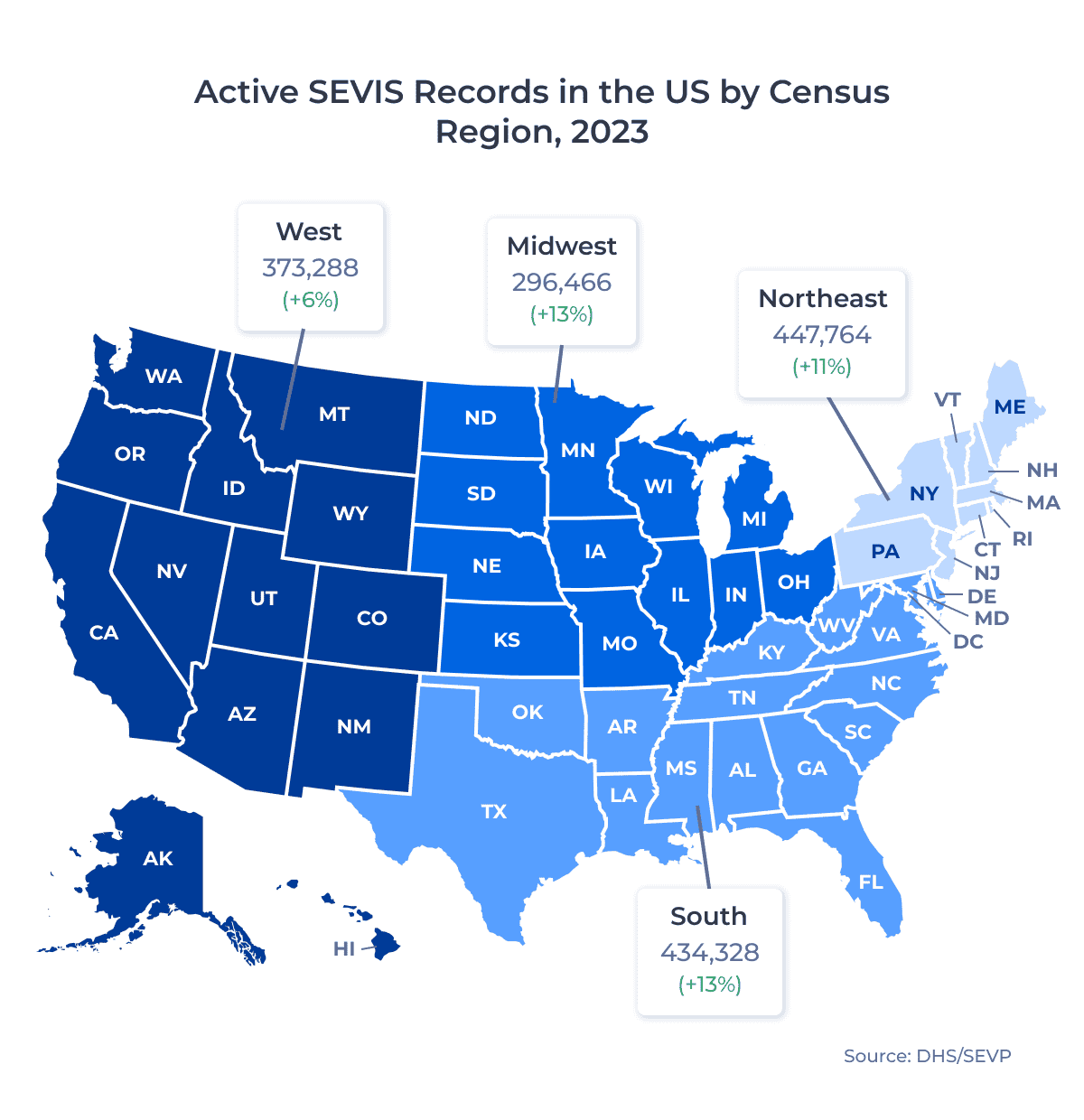International education in the US has been experiencing a resurgence in recent years, and its positive growth comes at a strategic point in time as policy shifts in other countries are impacting their ability to remain attractive to students. The latest SEVIS by the Numbers report shows that the US hosted over 1.5 million F-1 and M-1 students in 2023,1 continuing the upward momentum that began the previous year.2 About 90% of these students were enrolled in higher education.3
This positive trend positions the US well to take advantage of other destination markets experiencing falling student sentiment. For example, our most recent ApplyBoard Recruitment Partner (RP) Pulse Survey found that recent policy shifts in Canada, Australia, and the UK have made those destinations less attractive to international students. By capitalizing on its strengths and responding proactively to new challenges, the US can solidify its status as a leader in global education.
With that in mind, let’s take a closer look at this strong year for US international education. Discover how international student populations shifted in the country, which US regions grew the most, and what were the most popular primary majors.
Key Insights at a Glance
- 28 of the 30 largest international student populations in the US grew last year.
- The number of international students in the west, midwest, south, and northeast increased by at least 6% in each region in 2023 compared to the previous year.
- Diversity in STEM OPT is on the rise.4 In 2023, non-Indian students accounted for 61% of STEM OPT participation, up from 41% in 2018.
- Over 108,000 international students were enrolled or working in computer science, the most popular primary major in 2023.
International Students in the US in 2023
The 1.5 million international students in the US in 2023 represented a growth of 10% over 2022. The chart below dives into this growth:
International education in the US nearly returned to pre-pandemic levels in 2023, landing just 1% shy of 2019’s active student count.
This overall growth was led by increases in 28 of the US’s top 30 international student populations. The biggest news is that India surpassed China as the US’s largest source for international students in 2023. The US hosted nearly 378,000 Indian students last year—about 81,000 more than in 2022, representing growth of 27%.
The change at the top doesn’t mean that China declined in 2023. On the contrary, the number of Chinese students in the US rose by 2% last year. While this isn’t a huge shift, it marks the first time since 2017 that the Chinese student population in the US increased year-over-year.5
The biggest shift in the top 30 student populations was from Ghana. The 11,000 Ghanaian students in the US in 2023 represented an increase of 48% over the previous year. And we don’t expect this to be an outlier. Ghana has become a top source of students in other destination markets. As such, American institutions looking to expand their student recruitment may want to consider Ghana.
In addition to Ghana, there are opportunities across the globe for institutions to expand student recruitment. Within just the top 15 student populations,6 Brazil (+10%), Nigeria (+15%), Bangladesh (+30%), Colombia (+14%), and Nepal (+13%) all grew significantly in 2023.
Learn more about how the first half of the 2024 fiscal year signals strength for US international education.
Where Did International Students Study in the US in 2023?
International student populations in all US Census regions grew by at least 5% in 2023, compared to 2022. Which were the most popular regions and which grew the most? The map below shows the shift in active students in each US Census region last year:7

The South had the largest growth of all regions in 2023, up 13% compared to the previous year. State-wise, Texas led the way, growing by 19% over this period to host over 121,000 international students in 2023.
Although the Midwest continued to host fewer students than any other region in 2023, it also had a year-over-year growth rate of 13%. Illinois, the region’s most popular destination, grew by 18% over the previous year, reaching nearly 80,000 active students.
The Northeast once again hosted the most students in the US in 2023. Nearly 448,000 students studied in this region, nearly 11% more than in 2022. New York was the region’s most popular state, hosting nearly 170,000 international students last year. This represented a growth rate of 8% compared to 2022.
The West, up 6% in 2023, was the only region with a growth rate below 10%. However, California hosted nearly 238,000 active students in 2023, more than any other US state. The Golden State grew by 6% over the previous year.
The chart below allows you to select a US region and see which states in that region changed the most in 2023. Highlighting an individual bar will show you the overall change in active students:
International Students in STEM OPT in 2023
As detailed in our 2024 Trends Report, skills gaps in STEM fields are expected to grow in the US and abroad over the next decade. The graphics below dive into STEM OPT participation in 2023:8
More than 122,000 international students participated in STEM OPT in 2023. This represented growth of 2% over the previous year.
Diversity is critical for a healthy international education sector, as it protects destinations against downturns and provides students a wider range of learning opportunities. That’s why we’re encouraged to see that, since 2018, STEM OPT has become less reliant on Indian students. In 2018, non-Indian students represented just 41% of STEM OPT participation. In 2023, this figure rose to 61%, an increase of 20 percentage points.
This diversity shift means the US is gaining greater access to STEM talent from around the world. In 2018, only six student populations exceeded 1,000 participants in STEM OPT. By 2023, 14 student populations exceeded this threshold. Of these student populations, nine of them grew by over 10% year-over-year. The breadth of this growth is impressive, as it has resulted in a plurality of new voices entering STEM OPT as opposed to simply establishing a new majority student population.
Vietnam’s 25% growth rate was the largest among the top 10 student populations in STEM OPT in 2023.
What Did International Students Study in the US in 2023?
Critical to the success of the sector is knowing what programs students want to pursue. The table below shows the top 20 primary majors by active student count in 2023:
The top five primary majors remained the same rank in 2023 as in 2022, with the top four all growing significantly year-over-year. Computer science remained the most popular primary major in 2023. This field of study accounted for over 108,000 international students in the US in 2023, a growth of 19% over the previous year.
But this was only one part of the rising demand for STEM programs at US institutions. Another 78,000 studied computer and information sciences, general, which was 23% more than in 2022. Similarly, information technology rose by 25% and jumped up four spots, ending the year as the US’s eighth most popular major for international students.
The popularity and growth of computer-based primary majors aligns with what we’re seeing in our internal data. Technology, software engineering, computer programming and IT was ApplyBoard’s most-searched subcategory in 2023.
Key Takeaways
International education in the US continued its positive momentum in 2023, with active student numbers up nearly across the board. And, as we highlighted in our article about trends in the first half of the 2024 fiscal year, F-1 visas granted to students from China, Nepal, Myanmar (Burma), Vietnam, Ghana, and Pakistan rose significantly over the first half of 2023. The early signs point to a strong 2024.
With many competing destinations implementing policies that are hurting their reputation with international students, American institutions are poised to see a significant competitive advantage moving forward. Institutions seeking to capitalize on these ongoing developments should ensure that their recruitment materials emphasize the quality of education they offer as well as how they can help students develop their employability skills and build a professional network. Our Spring 2024 Student Pulse Survey found these are the three most important factors students consider when choosing where to study.
Subscribe to ApplyInsights
Sign up for the latest insights on international education.

About the ApplyInsights Team
FOOTNOTES:
1. F Student visas are academic (for study at an accredited K-12 school, college, or university, or studying English at an English language institute; the study must lead to a degree, diploma, or certificate); J Exchange visas are for participants in an exchange program either at the secondary school or university level; and M Student visas are for non-academic study (not including language programs), or vocational study or training.
2. All data courtesy of the US Department of Homeland Security (DHS) Student and Exchange Visitor Program (SEVP), unless otherwise noted.
3. Unless otherwise noted, all figures in this article refer to the total active student count, which includes primary and secondary students as well as students in OPT. Note that one student might partake in more than one level of education in a given calendar year, so they may be counted in multiple educational levels.
4. Optional Practical Training (OPT) is a type of work authorization that allows students to work in jobs related to their academic program for up to one year, either before or after they graduate (Pre-completion OPT or Post-completion OPT). STEM OPT is a 24-month extension of Post-completion OPT for students who have finished a designated science, technology, engineering, or math (STEM) degree. The list of eligible degrees is determined by DHS.
5. 2017 is as far back as the publicly available data goes.
6. Based on the total number of students in the US in 2023.
7. Note that the sum of the active SEVIS records by census region given in the report exceeds the report’s given active total for the US at large. This is likely an effect of the double counting that can occur across study levels (detailed above) and OPT participation (detailed below).
8. Note that the total number of international students working at any point during a calendar year may exceed the number of employment authorizations issued each year because STEM OPT extensions are two-year authorizations and OPT authorizations are granted on a rolling basis throughout the year.



